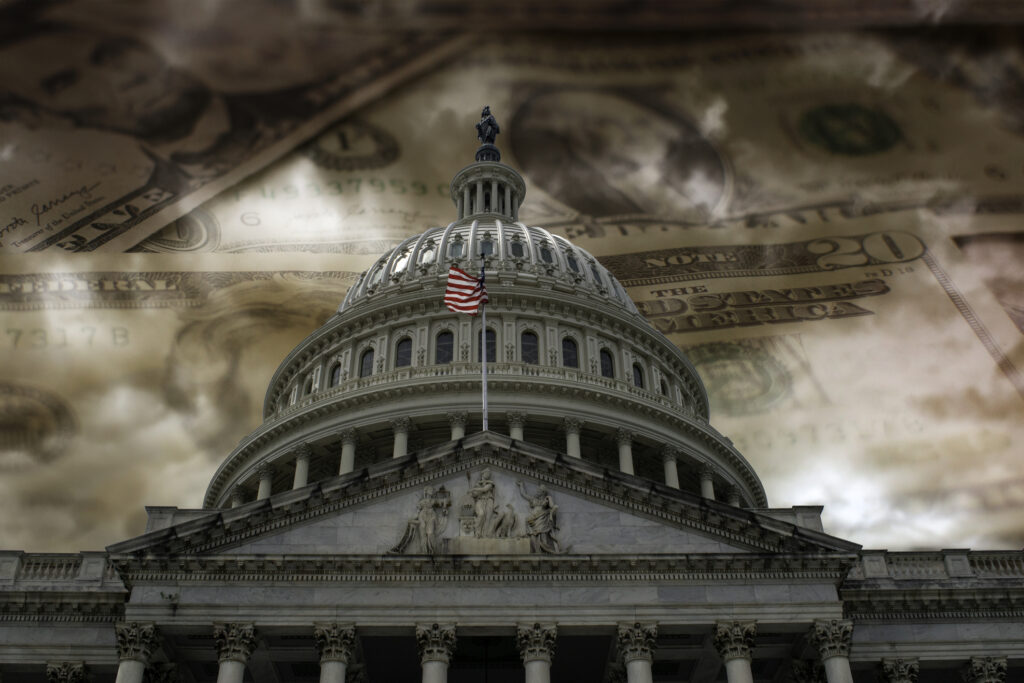U.S. federal spending is out of control, and has been for several decades. In 1970, the federal government’s budget totaled $232 billion. In 2024, federal spending will rise to $7.9 trillion, an increase of 3,320 percent over the past 54 years. Even worse, federal spending is forecast to surge to $12.95 trillion by 2038.
Decades of profligate spending has led to a perilous economic situation. As of 2023, the debt to GDP ratio is 119 percent, far higher than it was in 1970 at 34 percent. In 1970, the national debt stood at $371 billion. Today, it exceeds $33 trillion and is forecast to balloon to $45 trillion by 2027. Moreover, annual deficits are estimated to surpass $1.7 trillion for years to come and annual interest payments on the national debt will soon top $1 trillion.
In simple terms, the federal government’s spending spree, which has increased substantially in recent years due to “emergencies” such as the 2008 financial crisis and the 2020 COVID-19 pandemic, is completely unsustainable and must be reversed before it is too late.
There is, however, a model that can rein in federal spending and solve this burgeoning crisis. It is the same model that governments have employed to ensure that public utilities don’t gouge consumers.
Essentially, the solution would tether federal spending to the Consumer Price Index (CPI), with a wrinkle. It is called CPI-X (or “CPI minus X”). What works to keep publicly regulated utilities in check can also keep federal spending in check. This method is economically proven, objectively practical, and politically feasible.
In this paper, I will explain CPI-X and how it has been used without controversy to apply fiscal restraint to government-permitted monopolies or near-monopolies – such as public utilities (water, sewer, electricity, etc.) – in the United States, the United Kingdom, and Australia. I will also outline how CPI-X can be applied to something as complex and enormous as the federal budget of the U.S. government. Applying the CPI to federal spending is hardly a new concept. In fact, fiscal conservatives have proposed similar ideas, such as zero-baseline budgeting to impose common-sense fiscal restraints on federal spending. Unfortunately, all recent attempts to constrain federal spending have failed, as both Republicans and Democrats have continually called for bigger budgets without addressing the structural changes necessary to bring federal spending under control.
The version of CPI-X detailed in this paper provides a blueprint for fiscal-minded policy makers – whether in the federal government, state government, or at the local level – to apply sound and proven economic models using the CPI as a baseline, and achieving actual spending cuts via the “X” in the equation. The X-factors in CPI-X are derived from benchmarking the spending of the U.S. federal government, states, and other countries along 10 basic policy areas.
CPI-X cuts would be revolutionary and are policy-based because federal agencies are not directly comparable nor sufficiently documented. Nevertheless, agency-based cuts are modeled in parallel. The period for cuts would cover the next three presidential terms and would bring federal spending back to 2008 levels. The cuts would begin in 2025 at $7.4 trillion and finish in 2038 at $3.7 trillion. That is a 50 percent cut, and the savings of $75 trillion would result in complete debt retirement plus $19,347 in annual relief for taxpayers.
Lastly, this paper outlines 10 policy recommendations. The first three are short-term and directly related to CPI-X. The rest outline the creation of three institutions, three reviews, and one cost-benefit analysis that provides support over the medium- to long-term.
Because overspending has been a bipartisan problem in Washington, DC for many decades, drastic action is needed to change the present path. Although some fiscal conservatives tout solutions like a Balanced Budget Amendment as a cure-all for the constant increases in federal spending, this is a half-baked idea because it would also likely lead to steep tax increases in order to keep the federal government from accruing annual deficits. On the other hand, CPI-X addresses the problem directly by actually imposing extensive and long-overdue reductions in federal spending.
As this paper will detail, CPI-X is a sensible solution to decades of decadent federal spending that will deliver better fiscal management, an actual medium[1]term fiscal framework, and a less complex budgeting process. CPI-X also could, if strictly implemented over the long-term, completely eliminate the national debt in a timely manner while curbing inflation, spurring economic growth, and reducing taxes, thus reversing the U.S. government’s exceedingly deteriorating fiscal situation.




